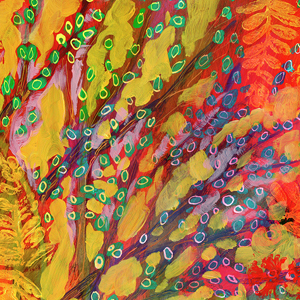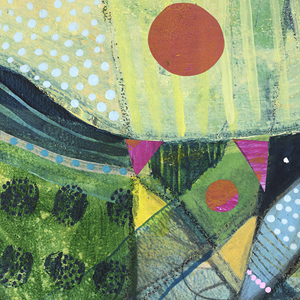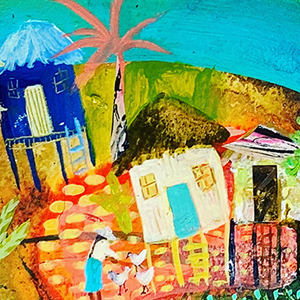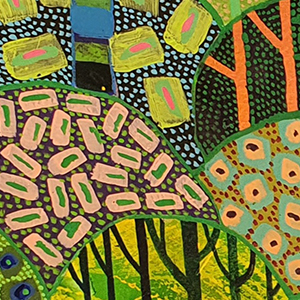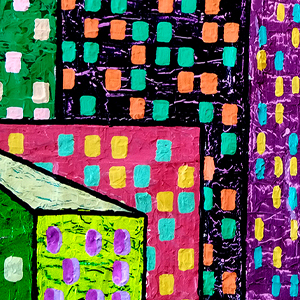
The Good Doctor
Generous Medicine
Sneha Mantri
Artwork: “Golden Boulevard II” by H. M. Saffer, II © 2020
It’s just after five at the end of a busy clinic day; I’m finishing my clinic notes and mentally preparing for the “Resistance and Social Justice” seminar I’ll be teaching in an hour to a group of interprofessional students. And then comes a knock on my door. A patient has arrived for their follow-up appointment on the wrong day. They’ve driven for hours, across state lines, to get here. They just need a prescription renewal. Can I just see them quickly before I leave? It’s not an uncommon scenario, especially in a subspecialty practice like mine. Some would advocate setting boundaries to avoid burnout—it’s after hours, there’s no appointment in the computer system, the “10-min prescription renewal” is likely to turn into a full 30-minute visit and then I’ll be late to my seminar.
Professional boundaries are important, of course, but a strict boundaries approach fails to recognize the persistent moral injury that comes from turning away a person in need, from failing to be generous with my time and expertise.
A parable from the epic Mahabharat illustrates the way generosity—giving without any expectation of return—has the power to be transformative for both the giver and the receiver. Fishing for a compliment, the warrior prince Arjun asks Krishna, a mortal representation of the god Vishnu, whether Arjun or his rival Karna is the more generous man. In answer, Krishna tells them each to distribute a huge vault of gold among the villagers. Arjun calls the villagers to come forward with containers, and for an entire day, he shovels gold into their baskets and buckets. Exhausted by the effort, Arjun goes to sleep feeling proud of himself for having accomplished the task and enriched the village. The next morning, however, he awakens to find the vault (being magical) has doubled in size. What’s more, word has gotten out, and the villagers are back for yet more gold. Between the limitless vault and the limitless need, the distribution of resources will consume all of Arjun’s time and energy.
By contrast, Karna looks at the vault, looks at the line of villagers, and simply says, “This gold is yours. Take as you see fit.” Unlike Arjun, Karna sees the vault of gold not as a symbol of his own largesse, but rather as something that belongs to the people, and thus the distribution of wealth belongs not with the ruling class but with the people themselves. Where does this response come from? One possibility is that Karna is himself of the people, albeit in a roundabout way. He was abandoned at birth by his unwed mother and adopted by a charioteer, an act of generosity that both shapes the young warrior’s character and subjects him to class-based ridicule at the hands of the nobly born Arjun. The irony, if I may issue a spoiler for a 3000-year-old story, is that Karna is actually Arjun’s older half-brother; when Karna learns this fact, he refuses to claim his birthright at the head of the Pandava clan, saying that his adoptive parents are his true parents because they loved him when he was at his most vulnerable.
The parallels between this tale and modern healthcare practice are illuminating. As a neurologist specializing in Parkinson’s disease (PD), I know that there are far more people with PD than I or my colleagues can possibly hope to treat. Nearly one million people are living with PD in North America, with only around 700 movement disorders physicians trained to treat them. Like Arjun, we take each patient individually, dispensing knowledge and medication, and yet we know that there will always be more patients to treat. In fact, only a small fraction of people with PD receive care from a movement disorders specialist, and predictably, those with fewer resources, or who live in rural communities or in underserved urban areas, are far less likely to access high-quality care and far more likely to develop serious complications of the disease.
What’s needed is a Karna approach to healthcare. Rather than addressing problems piecemeal, we need to restructure the way we think about health and disease. Empowering people with PD—or any chronic illness—to define research and funding priorities will be critical to stemming the rising tide of PD in the coming decades. Better education for all healthcare workers about the needs of people with PD, combined with better interprofessional collaboration, will help expand workforce capacity. And community partnerships—with senior centers, with retirement communities, with barbershops and nail salons—will bring care to the spaces where it’s most needed. Take my wrong-day patient, for instance. Empowering a pharmacist to issue a short-term refill of a chronic medication, empowering patients to advocate for cross-state telehealth benefits, empowering community centers to create or join group visits—any of these would have prevented a long car trip for the patient and a difficult end-of-day decision for me.
In the last several years, we have made some headway on generosity in medical care. The 2024 National Plan to End Parkinson’s Disease, a bipartisan, bicameral Act of Congress, directs the Department of Health and Human Services (HHS) to allocate resources specifically toward PD prevention and treatment. In particular, the Act instructs HHS to create a federal advisory council comprising not only PD researchers and clinicians, but also people living with PD and their care partners. This recognition of the importance of lived experience as a form of expertise has tremendous impact in terms of setting research and funding priorities in the coming decade. As an example, the 2011 National Alzheimer’s Project Act (NAPA), on which the National Plan to End Parkinson’s Disease was modeled, incorporates patients and care partners into the federal advisory council. NAPA has allocated almost $3 billion in federal funding toward Alzheimer’s research, prevention, and treatment, leading to far better integration of basic science (genetics, biomarkers, disease mechanisms) into pragmatic outcomes (quality of life, caregiver burden, disease complications). This generosity—not just funding but also the millions of patients and families volunteering for clinical trials—has fueled breakthrough treatments for Alzheimer’s. I dream of similar success for the National Plan to End Parkinson’s Disease.
Another form of generosity requires us to rethink care delivery models. Interprofessional education and collaboration (IPEC) have become far more common in healthcare settings than even a decade ago. In my own work as Medical Director of the Parkinson’s Foundation Center of Excellence at Duke, I am fortunate to lead a team of highly skilled and passionate clinicians, ranging from physicians and nurses to rehabilitation therapists to social workers and chaplains. We call ourselves THRIVE-PD: Transforming Health and Resilience through Interdisciplinary Visits and Engagement. By coming together once a week to see patients in an interdisciplinary “round robin” clinic, the THRIVE team provides better care than we could individually. I require each learner working with me to follow one patient through the THRIVE-PD clinic; more often than not, it’s the first time they’ve been able to witness a physical therapy balance test, or a clinical speech/swallow evaluation, or a social work needs assessment. In recognition of the importance of collaborative practice, educational accrediting bodies have begun to include IPEC competencies into assessment of learners and institutions. My own institution runs IPEC sessions focused on inpatient and emergency department care; my mission is to bring an IPEC lens into outpatient care for people with complex conditions like PD.
The area where I hope we grow in the coming decade is community-based care. The traditional model of care requires patients to travel to the clinic or medical center. For people with mobility or cognitive challenges, this can be a Herculean ordeal by itself; for people who have been devalued by healthcare (e.g. those living on the margins of society or who belong to racial, ethnic, or gender minority groups), the ask is impossible. Better academic-community partnerships can bring health promotion clinics to spaces where people already gather. Blood pressure screenings at ballgames, awareness events at gyms and malls—these are only the tip of the iceberg of what could be a truly community-integrated model of care. Imagine the benefits of receiving primary preventative care as part of a substance use recovery program, or a stroke prevention roadshow that travels to churches and county fairs. In other words, academic medicine needs to become generous with our time and resources, if we are truly to make a difference for the community we profess to serve.
The Karna approach may prove critical for the system, but it can also be an especially powerful way to promote the flourishing of individual doctors. In my own career, I’ve had several moments when generosity has transformed the entire shape of my story. During my masters’ program in narrative medicine, I was mentored by Dr. Rita Charon, who continues to be a sponsor and friend over a decade later. When I interviewed at Duke for a movement disorders faculty position and proposed the creation of a narrative medicine program, the chair of neurology Dr. Richard O’Brien agreed without hesitation, saying “If this is what drives you, we will make it happen”—and backed that promise with protected time until I could obtain external and internal funding for what has become the Armstrong Humanities Scholars Program, a four-year longitudinal track for medical students interested in health humanities as a force for social justice and structural change in healthcare.
Most remarkable of all, a few months ago I was selected by the Josiah Macy Jr. Foundation as one of five Faculty Scholars in the 2024 cohort. The recognition and funding that accompanies the Faculty Scholars Program will allow me to refocus my time and effort for the next two years on expanding the Armstrong Humanities Scholars Program to interprofessional programs across the health system campus. But more than that, the generosity of the Macy Foundation, and Duke’s Purpose Project before it, has been transformative at a time when I wasn’t sure my values had a place in the modern academic medical center, which can feel increasingly corporatized and sterile. At the Kickoff and Annual Meeting this June, I was astounded and heartened to be in a room with physicians and nurses doing innovative work around moral formation and structural change in health professions education. I was inspired by the work of the cohorts that came before me and excited to see how my own cohort will develop and grow alongside each other in the next two years.
The Macy Faculty Scholars Program will also round out my second decade in academic medicine, as I’ve grown from student to resident and fellow, and now faculty. The world is superficially different than it was in 2007 when I set foot in Columbia University’s College of Physicians and Surgeons, but the fundamental values of healthcare—to take care of persons and populations—haven’t changed. When people feel valued not just for their efficiency and productivity, but for their unique contribution and connection with others, they regain the capacity to be generous. And generosity need not be only financial. Generosity can be verbal—specific compliments or public praise that uplifts another person. Generosity can be creative—home-baked goods or hand-made objects are universally popular. Generosity can be attentional—being fully present with another human being.
As I approach that 20-year anniversary, I hope to see more generosity across our campus and clinics. Generosity towards our patients, who need a different sort of care than our traditional fee-for-service model can provide.
Generosity towards our learners, through whose wide-eyed wonder we can learn to see anew. Generosity towards our colleagues, who provide more care to our patients and each other than gets documented or billed. And lastly, generosity towards ourselves, as we work together to reimagine what healthcare should look like in the next quarter-century and beyond.
 Sneha Mantri, MD, MS, is an associate professor of neurology and a movement disorders specialist at Duke University School of Medicine, with a clinical practice focused on the care of people with Parkinson disease (PWP) and other movement disorders. In 2020, Dr. Mantri was appointed Director of Medical Humanities at the Trent Center for Bioethics, Humanities, and History of Medicine, leading a team of clinician scholars in understanding moral injury and structural inequities in medicine.
Sneha Mantri, MD, MS, is an associate professor of neurology and a movement disorders specialist at Duke University School of Medicine, with a clinical practice focused on the care of people with Parkinson disease (PWP) and other movement disorders. In 2020, Dr. Mantri was appointed Director of Medical Humanities at the Trent Center for Bioethics, Humanities, and History of Medicine, leading a team of clinician scholars in understanding moral injury and structural inequities in medicine.
Fall 2024
Part I: Abundant Virtue
Laurie L. Patton
Sarah A. Schnitker
Patricia Snell Herzog
Melissa Fitzpatrick
Dirk Philipsen
Interlude: Generous Eyes, Radical Love
Fr. Martin Lam Nguyen, CSC
Part II: Abundant Vocation
MORE






